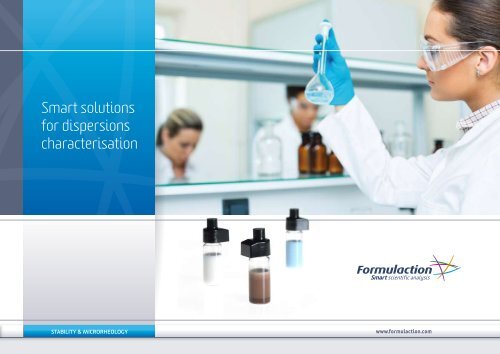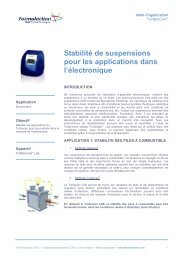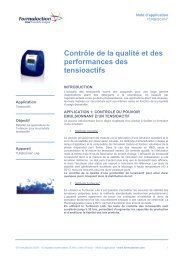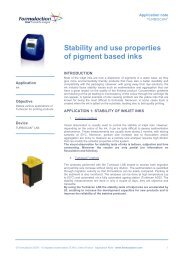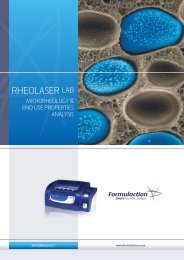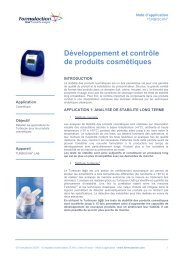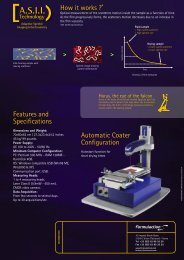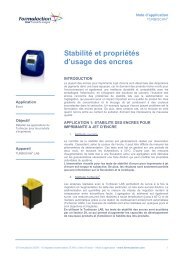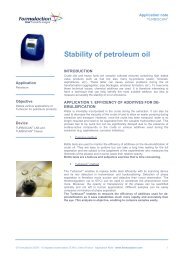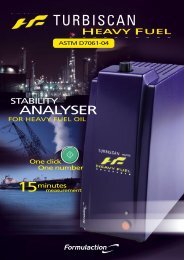Smart solutions for dispersions characterisation - Formulaction
Smart solutions for dispersions characterisation - Formulaction
Smart solutions for dispersions characterisation - Formulaction
You also want an ePaper? Increase the reach of your titles
YUMPU automatically turns print PDFs into web optimized ePapers that Google loves.
<strong>Smart</strong> <strong>solutions</strong><br />
<strong>for</strong> <strong>dispersions</strong><br />
<strong>characterisation</strong><br />
STABILITY & MICRORHEOLOGY<br />
www.<strong>for</strong>mulaction.com
Austria<br />
Belgium<br />
Czech Republic<br />
Denmark<br />
Finland<br />
France<br />
Germany<br />
Greece<br />
Hungary<br />
Ireland<br />
Italy<br />
Luxembourg<br />
Netherland<br />
Norway<br />
Poland<br />
Portugal<br />
Spain<br />
Sweden<br />
Switzerland<br />
UK<br />
Ukraine<br />
Argentina<br />
Brazil<br />
Canada<br />
Columbia<br />
Costa Rica<br />
Cuba<br />
Mexico<br />
USA<br />
Venezuela<br />
00<br />
Iran<br />
Israel<br />
Kingdom of Saudi Arabia<br />
Qatar<br />
South Africa<br />
Turkey<br />
United Arab Emirates<br />
Australia<br />
China<br />
India<br />
Japan<br />
Malaysia<br />
New Zealand<br />
Russia<br />
Singapore<br />
South Korea<br />
Taiwan<br />
Thailand<br />
Content<br />
01 FORMULACTION SPIRIT................................................1<br />
02 STABILITY ..................................................................................2<br />
Technology : Multiple Light Scattering ..........................3<br />
Stability applications ...................................................................4<br />
Discover the brand new Turbiscan Tower ...................5<br />
TURBISCAN Range ........................................................................6<br />
03 MICRORHEOLOGY ..............................................................8<br />
Technology: Diffusing Wave Spectroscopy ................9<br />
Microrheology applications.................................................10<br />
RHEOLASER Range - Bulk ...................................................11<br />
HORUS Range – Films & Coatings ................................12<br />
04 INSTRUMENT SPECIFICATIONS ..........................13
01 For<br />
FORMULACTION spirit is summarized in 3 words:<br />
Pioneer, Dynamic, Worldwide<br />
Some key numbers:<br />
More than 1500 R&D Labs equipped<br />
More than 1000 publications<br />
More than 200 patents<br />
Represented in more than 50 countries worldwide<br />
<strong>Smart</strong> <strong>solutions</strong><br />
<strong>for</strong> dispersion<br />
<strong>characterisation</strong><br />
20 years, <strong>Formulaction</strong>’s wish is to provide <strong>for</strong>mulators with valuable in<strong>for</strong>mation to characterize<br />
<strong>dispersions</strong> in terms of physical stability & viscoelastic properties. Because of the complex nature and<br />
fragile equilibrium of emulsions & suspensions, our aim is to offer analytical <strong>solutions</strong> which analyse the<br />
sample in its native state. Our instruments are dedicated to R&D scientists, researchers and technicians<br />
who want to develop, optimize, manufacture and control high quality products.<br />
PIONNEER<br />
In 1994, <strong>Formulaction</strong> was a pioneer in the<br />
field of physical stability by offering the<br />
TURBISCAN TM , the first instrument able to<br />
analyse concentrated <strong>dispersions</strong> without<br />
dilution thanks to the patented Multiple Light<br />
Scattering technology.<br />
In 2006 <strong>Formulaction</strong> was the first company<br />
to use the Diffusing Wave Spectroscopy<br />
principle of measurement to analyse film<br />
<strong>for</strong>mation thanks to the HORUS TM .<br />
In 2009 <strong>Formulaction</strong> was pioneer in the<br />
field of Microrheology by offering the first<br />
ready to use instrument RHEOLASER TM to<br />
study viscoelastic evolutions of liquid and<br />
semi-liquid <strong>dispersions</strong>.<br />
Home &<br />
Personal Care<br />
DYNAMIC<br />
Today <strong>Formulaction</strong> is the leading company<br />
in the field of the characterization of<br />
concentrated <strong>dispersions</strong>. We keep on innovating<br />
to offer you the best <strong>solutions</strong> <strong>for</strong> a<br />
better analysis and understanding of your<br />
<strong>for</strong>mulas, with highly skilled employees in<br />
domains such as chemistry, physics, optics<br />
and mechanics...<br />
Our partnerships with Research Institutes<br />
and Universities, our membership in scientific<br />
organizations (ISO, American Chemical<br />
Society, French Chemical Society…) allow<br />
us to offer a high level of expertise in the<br />
field.<br />
<strong>Formulaction</strong> covers many application fields<br />
thanks to the versatility of our technologies.<br />
Food Pharmaceuticals Paint & Ink<br />
<strong>Formulaction</strong> Spirit<br />
WORLDWIDE<br />
<strong>Formulaction</strong> is represented in more than<br />
50 countries all over the world thanks to<br />
an efficient and well-trained distributor’s<br />
network and 1 subsidiary in USA. Supporting<br />
our worldwide partners is one of our top<br />
priorities in order to be close to our users.<br />
Oil &<br />
Petroleum<br />
,,<br />
This is what has made <strong>Formulaction</strong> successful<br />
<strong>for</strong> more than 20 years. Our clients’ loyalty and<br />
trust is our best reward. ,,<br />
... and<br />
many more.<br />
1
2<br />
02<br />
Master your<br />
<strong>dispersions</strong><br />
stability<br />
Searching <strong>for</strong><br />
Stability
TURBISCAN is<br />
the reference <strong>for</strong><br />
stability analysis<br />
Turbiscan is used world-wide<br />
to detect at an early stage all<br />
kinds of destabilisation such as<br />
coalescence, flocculation, creaming,<br />
sedimentation, etc… Various<br />
products such as emulsions,<br />
suspensions or foams can be studied<br />
from low to high concentrations<br />
without any sample preparation or<br />
dilution.<br />
Stability kinetics and index are<br />
measured <strong>for</strong> an efficient sample<br />
analysis and comparison.<br />
Multiple Light Scattering<br />
Optical measurement of particles concentration and size<br />
MLS SOLUTIONS<br />
The Turbiscan works on Multiple Light<br />
Scattering in both Transmission (T) and<br />
Backscattering (BS) mode, in order to<br />
analyse low and high concentration<br />
<strong>dispersions</strong>.<br />
T &BS signals depend on particle size and<br />
concentration: BS & T = f ( d /ϕ)<br />
- Size range: 1 nm to 1 mm ;<br />
- Concentration range: 0.0001 to 95% v/v ;<br />
SCAN CONFIGURATION<br />
The Turbiscan acquires T & BS every 20<br />
microns along the sample height, thanks to<br />
a patented scanning reading head.<br />
Scans are repeated during sample ageing<br />
time to detect any variation of the signal<br />
due to a destabilisation, such as<br />
particle migration and/or particle size<br />
variation.<br />
Light Source<br />
(Near IR)<br />
Backscatter<br />
Detector<br />
Transmission<br />
Detector<br />
DATA REPORTING<br />
The software provides multi-level data<br />
treatment <strong>for</strong> both experts and nonexperts.<br />
- The Turbiscan Stability Index (TSI)<br />
is a one-click feature providing the key<br />
number depending on the global stability<br />
of the sample. It is a quick and easy way<br />
to characterize the sample, and enables<br />
the user to compare & rank various<br />
<strong>for</strong>mulations.<br />
- Kinetics computation based on the raw<br />
signal allows to identify and quantify<br />
in detail the phenomena taking place<br />
in the samples, depending on size and<br />
concentration variations.<br />
- The user can compute the evolution<br />
of the mean particles diameter or<br />
concentration during the ageing of the<br />
product in any part of the sample.<br />
Light Source<br />
Detector<br />
Light Source<br />
Detector<br />
BS=70%<br />
BS=35%<br />
Multiple Light Scattering<br />
STABILITY<br />
No variation of BS and T<br />
STABILITY<br />
PARTICLE MIGRATION<br />
Local peaks of variation of BS or T<br />
SEDIMENTATION<br />
CREAMING<br />
PARTICLE SIZE VARIATION<br />
Global variation of BS or T on the<br />
whole height<br />
COALESCENCE /<br />
FLOCCULATION<br />
3
4<br />
Stability applications<br />
HOME & PERSONNAL CARE<br />
- Emulsions, lotions, creams: Decrease<br />
significantly time of stability analyses (up to<br />
200 times).<br />
- Sun creams: Difficult to analyze by visual<br />
observation, Turbiscan detects and quantifies<br />
the destabilization of the different particles.<br />
- Make-up: Detects sedimentation of<br />
foundation, nail varnish, lipsticks.<br />
- Foams: Easy way to follow the bubble<br />
ripening and the drainage.<br />
- Shampoos: Stability of pearlescent agent.<br />
PHARMACEUTICALS<br />
- Vaccines: Kinetic of particles aggregation<br />
and sedimentation (proteins, metal oxides...).<br />
- Skin lotions and creams: Detection of<br />
coalescence and creaming up to 200 times<br />
faster than visual test.<br />
- Ophthalmic suspensions: Study of the redispersion<br />
of active ingredient after storage.<br />
- Inhalers (pMDI): Study of particles<br />
aggregation & sedimentation in pressurized<br />
measurement cells.<br />
PAINT & INK<br />
- Sedimentation: Analyse the settling rate in<br />
suspension.<br />
- Aggregation: Monitor the size variation in the<br />
suspension.<br />
- Packing: Analyse the <strong>for</strong>mation of a cake at<br />
the bottom of the sample.<br />
- Redispersibility: Be sure that shaking or<br />
stirring gives your sample its initial properties<br />
back.<br />
FOOD<br />
- Dairy products: Quantify and detect characteristic<br />
destabilization of milk based products : particle size<br />
variation, creaming of fat droplets, sedimentation of<br />
calcium or chocolate particles.<br />
- Flavor emulsions: no dilution required to detect droplet<br />
size variation.<br />
- Soft drinks: ring <strong>for</strong>mation, color change, pulp<br />
sedimentation.<br />
- Desserts: Detect destabilization phenomena of cream,<br />
dessert foam, ice cream.<br />
- Raw materials: monitor the efficiency of stabilizers,<br />
thickeners…<br />
OIL & PETROLEUM<br />
- Stability of Fuel oils: Analyze stability reserve in 15 minutes<br />
thanks to the ASTM D706.<br />
- Stability of Crude oils: Analyse aggregation and<br />
sedimentation kinetic of asphaltenes.<br />
- Efficiency of additives <strong>for</strong> demulsification: Qualify the<br />
best additive in order to de-emulsify water-in-oil emulsions.<br />
- Efficiency of dispersants <strong>for</strong> asphaltenes: Measure<br />
asphaltene aggregation kinetics versus dispersant amount.<br />
- Quantification of amount of additive: Save costs by using<br />
just needed quantity of additive.<br />
- Stability of drilling fluids: Detect and quantify<br />
destabilization phenomena.<br />
ELECTRONICS<br />
- Slurries (CMP...): easily check the homogeneity & stability<br />
of slurries be<strong>for</strong>e next steps of the process.<br />
- Electronic components (MLCC...): quality of the<br />
dispersion state during the production of Multi-Layer<br />
Ceramic Capacitors.<br />
- DisplaY (LCD, LED, e-Paper, QD...): influence of additives<br />
on dispersion stability.<br />
- Energy (Solar cells, Fuel cells, Secondary battery,<br />
DSSC...): quality and homogeneity of the inks coated to the<br />
solar cells.<br />
- Printed electronics (Conductive inks, RFID, Flexible<br />
displays...): check the size variation of nano particles in<br />
electronic inks.<br />
And many more:<br />
Ceramics, agrochemicals, adhesives, lubricants, raw materials, water treatment, mining, etc…<br />
BENEFITS<br />
NON-CONTACT MEASUREMENT - TRUE STABILITY<br />
Measurement is done without any mechanical or external<br />
stress, and without any dilution, thus allowing the monitoring of<br />
the ageing of the product.<br />
OPTICAL AND THERMAL ACCELERATION<br />
Thanks to the high optical resolution (up to 100x faster) and<br />
the possibility of high storage temperatures (up to 200x faster),<br />
stability tests have never been shorter.<br />
IDENTIFICATION AND QUANTIFICATION<br />
Easily identify and quantify the destabilisation phenomena in<br />
the samples, in order to rank and compare all your <strong>for</strong>mulas.<br />
VERSATILE TECHNOLOGY<br />
The user can study all kinds of liquid <strong>dispersions</strong> (emulsions,<br />
suspensions, foams, etc…), with concentration up to 95% v/v,<br />
over a wide range of sizes (1 nm to 1 mm).
Be on Top of your<br />
Dispersions Stability<br />
True Stability<br />
thanks to analysis under<br />
real conditions (no stress),<br />
up to 200 times faster than<br />
visual observation<br />
Up to 6 samples<br />
more samples at a time,<br />
in a reduced space, thanks to a<br />
vertical design<br />
4 – 80°C<br />
temperature range<br />
<strong>for</strong> a better control and<br />
simulation of shelf-life conditions<br />
State of the art software<br />
new Turbisoft 2.0 <strong>for</strong> easy and<br />
automated comparisons of your<br />
samples’ stability<br />
The New Reference<br />
5
PROCESS<br />
6<br />
Turbiscan Range<br />
TURBISCAN ON-LINE<br />
From lab to production scale<br />
Process design, scale-up and control are<br />
key steps to guarantee the quality of the<br />
manufactured products. This instrument<br />
is designed <strong>for</strong> laboratory conditions and<br />
production constraints, allowing to control<br />
any process.<br />
• Measurement in real time (up to 0.1s<br />
frequency)<br />
• Monitor the dispersion state during<br />
process (emulsification, grinding,<br />
precipitation, etc…)<br />
• Working conditions: 5 – 100°C / 1– 10<br />
bar<br />
1<br />
No<br />
TURBISCAN HEAVY FUEL<br />
Dedicated to Oil & Petroleum<br />
This adapted version of the Turbiscan<br />
Classic measures the stability of fuel oil,<br />
crude oil, drilling fluids, effect of additives,<br />
water-in-oil demulsification.<br />
• Easy to use with its 1-click software<br />
• Portable and robust<br />
• Compliant with ASTM D 7061: <strong>for</strong><br />
Heavy Fuel Oil analysis (determine the<br />
Stability reserve)<br />
COMPUTATION<br />
Turbiscan<br />
Stability Index<br />
Based directly on the raw<br />
data, this unique number<br />
takes all destabilisation into<br />
account, providing you with<br />
a powerful tool to rank &<br />
compare all your <strong>for</strong>mulas in<br />
just one-click.<br />
Determining shelf-life of<br />
your products has never<br />
been easier!<br />
TURBISCAN CLASSIC<br />
Basics of the technology<br />
<strong>for</strong> short-term stability<br />
Turbiscan Classic helps to optimise the<br />
pre-<strong>for</strong>mulation work by giving a quick<br />
insight into the instability phenomena. The<br />
first generation of Turbiscan range is still a<br />
success after 20 years:<br />
• Identification and quantification of<br />
instability<br />
• Quick and Reliable<br />
• Robust<br />
1<br />
No
Available in Nano version :<br />
explore even lower<br />
concentration and size<br />
Accelerate and document ageing tests<br />
<strong>for</strong> a fast and deep understanding of<br />
destabilisation mechanisms (creaming,<br />
sedimentation, flocculation, coalescence).<br />
Turbiscan LAB can be used in both<br />
R&D lab <strong>for</strong> <strong>for</strong>mulation development<br />
and QC labs to control the stability of raw<br />
materials and final products.<br />
• Identification and quantification of<br />
instability<br />
• Long-term stability analysis<br />
• From RT to 60°C<br />
1<br />
RT-60°C<br />
The brand new spearhead of the Turbiscan<br />
range to fully characterise the stability<br />
of concentrated <strong>dispersions</strong> (emulsions,<br />
suspensions, foams). Discover its new<br />
patented mechanical design, <strong>for</strong> an even<br />
better per<strong>for</strong>mance.<br />
• Up to 6 samples at a time<br />
• From 4°C to 80°C<br />
• Higher vertical resolution: acquisitions<br />
every 20 microns.<br />
Turbiscan Range<br />
TURBISCAN LAB TURBISCAN TURBISCAN AGS<br />
The reference stability analyser The new reference, 6 times better<br />
High throughput stability analyser<br />
6<br />
4-80°C<br />
High throughput screening is more and<br />
more useful to shorten the <strong>for</strong>mulations<br />
time-to-market. Turbiscan AGS<br />
integrates the Turbiscan LAB, a robot, a<br />
storage station and a smart software <strong>for</strong><br />
automatic sample handling and treatment.<br />
This concept enables an automated<br />
management of ageing tests from sample<br />
storage at different temperatures to shelflife<br />
determination.<br />
• Up to 54 samples<br />
• 3 storage racks from RT to 60°C<br />
• Traceability, reproducibility,<br />
objectivity<br />
54<br />
RT-60°C<br />
7
8<br />
03<br />
Explore<br />
rheology at<br />
the nano-scale
MICRORHEOLOGY:<br />
the best solution<br />
<strong>for</strong> viscoelasticity<br />
analysis at rest<br />
Microrheology enables the<br />
measurement of the evolution<br />
of the viscosity and elasticity, in<br />
bulk samples (Rheolaser) or in<br />
films (Horus). The measurement is<br />
per<strong>for</strong>med at rest, as no mechanical<br />
stress is applied to the sample.<br />
This technique allows monitoring of<br />
sample evolution, such as gelation,<br />
rheology ageing, stability, but also<br />
drying of coatings.<br />
Diffusing Wave Spectroscopy<br />
Optical measurement of particles mobility<br />
DWS SOLUTIONS<br />
Our microrheology analysers use MS-<br />
DWS (Multi-Speckle Diffusing Wave<br />
Spectroscopy) principle of measurement.<br />
It corresponds to Dynamic Light Scattering<br />
extended to concentrated <strong>dispersions</strong>. It<br />
measures the particles Brownian motion<br />
which depends on the viscoelastic<br />
structure of the sample. This technique<br />
consists in sending a coherent laser beam<br />
into the sample, leading to interfering<br />
waves which create a speckle pattern<br />
captured with a video camera detector.<br />
The variations of this speckle image are<br />
directly linked to the particles Brownian<br />
motion, their speed and the distance they<br />
explore.<br />
MULTI-PIXEL<br />
DETECTOR<br />
LASER<br />
LIGHT SOURCE<br />
PRINCIPLE OF MEASUREMENT<br />
INTERFERING WAVES<br />
SCATTERING<br />
PARTICLE MEAN SQUARE<br />
DISPLACEMENT (MSD)<br />
Brownian motion of the particle is<br />
reported as the particle Mean Square<br />
Displacement d2 (MSD) versus time. This<br />
MSD curve enables the <strong>characterisation</strong> of<br />
the viscoelastic properties of the sample.<br />
The particles MSD in a purely viscous<br />
fluid grows linearly with time, while in a<br />
t dec(s)<br />
viscoelastic fluid the particles are limited in<br />
1 10 102103 10-1 their displacement as they are trapped in<br />
the 3 dimensional microstructure network<br />
leading to a plateau in the MSD curve.<br />
MSD (nm 2 )<br />
d2 d2 Viscous<br />
Visco-elastic<br />
RHEOLOGY EVOLUTION<br />
This non-contact and non-destructive<br />
measurement enables the monitoring on<br />
the very same sample of the t dec(s) viscoelastic<br />
evolution versus ageing time by repeating<br />
1 102104 10-2 1 10 10<br />
the acquisition of particles MSD.<br />
2 103 10-1 MSD (nm2 MSD ) (nm2 )<br />
10 -1<br />
10 -2<br />
10 -2<br />
1 10 10 2 10 3<br />
Viscous<br />
1 10 2 10 4<br />
Viscous<br />
1 10 2 10 4<br />
Diffusing Wave Spectroscopy<br />
MSD (nm 2 )<br />
Liquid Gel variable<br />
(pH, T, conc...)<br />
Sol-Gel transition<br />
Solid<br />
t dec(s) t dec(s)<br />
t dec(s)<br />
Visco-elastic<br />
Visco-elastic<br />
MSD (nm2 MSD (nm ) 2 )<br />
Liquid<br />
Liquid a<br />
Gel variable<br />
b<br />
(pH, T, conc...)<br />
t t<br />
dec(s) t dec(s)<br />
MSD (nma,b 2 )<br />
Sol-Gel transition<br />
MSD (nm 2 )<br />
Gel point<br />
Liquid a<br />
Liquid Solid<br />
Solid<br />
Gel variable<br />
(pH, T, conc..<br />
Sol-Gel transition<br />
t dec(s) t dec(s)<br />
a,b<br />
SOL-GEL ANALYSIS<br />
When a gel is <strong>for</strong>ming, the sample’s<br />
rheology evolves from liquid state<br />
to solid state (Sol-Gel transition).<br />
Using a mechanical rheometer<br />
requires expertise and caution<br />
(weak gels may face slipping<br />
effects or fracture phenomena<br />
due to the mechanical stress).<br />
Acquisitions of Particles MSD<br />
curves as a function of gel variables<br />
(Time, Temperature, Concentration,<br />
pH…) enable the monitoring of the<br />
sol-gel process. Rescaling data<br />
processin (a, b), known in rheology<br />
as “Time Cure Superposition”<br />
may be applied to determine with<br />
high precision gel point and gel<br />
strength parameters.<br />
Liquid<br />
Gel variable (T, pH, Conc...) a<br />
t dec(s) b<br />
MSD (nm 2 )<br />
b<br />
Gel point<br />
Solid<br />
9<br />
Solid<br />
Solid
10<br />
Microrheology applications<br />
FILM FORMATION ANALYSIS VISCOELASTIC ANALYSIS IN BULK<br />
PAINT<br />
Monitor in real-time mechanisms and<br />
characteristic times of drying of waterborne or<br />
solvent-based paints:<br />
- Determine accurately the open-time.<br />
- Control the dust-free time, touch-free time,<br />
dry-hard time, etc…<br />
- Monitor effect of a thickener or additive.<br />
INK<br />
Study drying kinetics on any substrates<br />
(glass, wood, plastic, paper, etc…)<br />
- Gravure inks.<br />
- Paper inks.<br />
- e-inks.<br />
COSMETICS<br />
Control the drying properties of cosmetics<br />
products with a better accuracy:<br />
- Drying of nail varnishes.<br />
- Evolution of a mascara.<br />
- Crystallization of lipstick.<br />
& MANY OTHERS<br />
Thanks to this versatile technology, explore the<br />
drying properties of various systems in many<br />
other application fields:<br />
- UV-curing of specialty products.<br />
- Control the drying of glues.<br />
- Etc...<br />
FOOD<br />
- Monitor gelation of yoghurts versus time, temperature or pH.<br />
- Characterize the texture of salad dressing, creams,<br />
mayonnaise, etc…<br />
HOME & PERSONAL CARE<br />
- Determine ideal concentration of softeners to reduce<br />
packaging size.<br />
- Control the texture of cosmetic creams or toothpastes.<br />
- Analyse the rheology and stability of shampoos.<br />
PHARMACEUTICALS<br />
- Adapt thickener concentration <strong>for</strong> cough syrups.<br />
- Control the gel properties of eye-drops.<br />
- Characterise the rate of delivery of polymer-based drugs.<br />
PAINT & INK<br />
- Control the texture and behaviour of non-drip paints.<br />
- Monitor the speed of recovery after application of the paint<br />
(brushing, spraying…).<br />
MATERIALS<br />
- Determine the pot-life of composite components.<br />
- Monitor effect of additives on cement setting.<br />
& MANY OTHERS<br />
- Measure the rheology of polymer <strong>dispersions</strong> <strong>for</strong> Oil<br />
Recovery.<br />
- Characterise the behaviour of slurries, lubricants, etc…<br />
BENEFITS<br />
NON CONTACT MEASUREMENT<br />
Measurement is per<strong>for</strong>med without any mechanical stress. It allows<br />
the analysis of fragile materials (weak gels, creams, etc…)<br />
without sample modification nor destruction.<br />
VISCOELASTIC PROPERTIES VS. TIME<br />
• Gelation process ;<br />
• Structure recovery ;<br />
• Long-term stability ;<br />
EASY SAMPLE HANDLING<br />
• No evaporation or drying (Rheolaser) / Open environment (Horus);<br />
• No geometry configuration ;<br />
• Disposable measurement cell (Rheolaser) ;
RHEOLASER: explore<br />
rheology at rest<br />
The Rheolaser is dedicated to <strong>for</strong>mulators interested in the<br />
end-use properties of their products, such as gelation, stress<br />
recovery, shape stability, long-term stability & many others...<br />
The Rheolaser Master is specifically designed <strong>for</strong> monitoring<br />
viscoelastic evolutions such as SOL-GEL transition (gelation),<br />
viscoelastic changes during ageing or recovery, on the very<br />
same sample. It also includes l* measurement (optical transport<br />
path of the photons) to monitor in real-time any dispersion<br />
state variation in the sample, such as particles size variation or<br />
particles migration.<br />
MAIN ADVANTAGES<br />
• Measurement AT REST (zero-shear), non-intrusive & non-destructive.<br />
• One-click experiment & results (no parameters needed)<br />
• Ageing analysis on the very same sample, with an easy<br />
sampling<br />
• Hazardous samples can be analysed in a closed glass cell<br />
KEY PARAMETERS<br />
These parameters are kinetics, meaning the user can monitor<br />
the evolution of any product versus ageing time.<br />
SOLID-LIQUID BALANCE (SLB), ratio between the solid-like and<br />
the liquid-like behaviour of the studied sample.<br />
- Monitor properties such as: adhesion, spreadability, gel point,<br />
shape stability, physical stability, etc...<br />
ELASTICITY INDEX (EI), elasticity strength in the studied sample.<br />
- Monitor properties such as: mesh/pore size, hardness, recovery,<br />
gelation, etc...<br />
MACROSCOPIC VISCOSITY INDEX (MVI), quantify and compare<br />
the macroscopic viscosity at zero-shear.<br />
- Monitor properties such as: effect of a thickening agent, texture,<br />
flowability, long-term stability, etc...<br />
TIME CURE SUPERPOSITION (TCS), determine gel points with<br />
great accuracy.<br />
Rheolaser Range<br />
RHEOLASER LAB & LAB6 RHEOLASER<br />
Basics of the technology<br />
<strong>for</strong> microrheology analysis<br />
The first ready-to-use microrheology<br />
instrument to analyse <strong>for</strong>mulated products<br />
such as creams, gels or polymer-based<br />
emulsions.<br />
• 6 storage positions<br />
• Up to 6 simultaneous measurements<br />
• From RT to 60°C<br />
The new spearhead of the<br />
microrheology range<br />
The new state-of-the-art device, dedicated<br />
to monitoring evolution of the rheological<br />
properties, such as viscoelasticity change<br />
versus ageing time, or sol-gel transition<br />
with high accuracy thanks to the Time<br />
Cure Superposition method (see page 9)<br />
• 6 simultaneous measurements<br />
• From RT to 90°C<br />
• Time Cure Superposition treatment<br />
<strong>for</strong> accurate gel point determination<br />
• l* to monitor macroscopic evolution<br />
(size and concentration)<br />
11
12<br />
Horus Range<br />
HORUS: contact-free film<br />
<strong>for</strong>mation analyser<br />
The very first commercial instrument based on MS-DWS technology,<br />
the Horus enables monitoring of microstructure changes during<br />
the film <strong>for</strong>mation process. It identifies the drying mechanisms and<br />
characteristic drying times on any kind of substrate. It works on<br />
any kind of films-<strong>for</strong>ming product or coating, such as inks, paints,<br />
varnishes, resins, binders, cosmetic films…<br />
MAIN ADVANTAGES<br />
• Non-intrusive method<br />
• Microstructure analysis<br />
• Measurement on any kind of substrate<br />
FLUIDITY FACTOR: A UNIQUE PARAMETER<br />
TO MONITOR FILM FORMATION<br />
Thanks to the unique and patented A.S.I.I (Adaptive Speckle Image<br />
Interferometry) processing, evolution of the “Fluidity Factor” versus time<br />
is displayed in real time providing a wide range of in<strong>for</strong>mation such as:<br />
• Drying time (open time, touch-dry time, dry-hard time, …)<br />
• Curing time<br />
• Microstructure change (particle packing, particle de<strong>for</strong>mation,<br />
curing…)<br />
A VERSATILE DEVICE<br />
Horus has been designed as an open configuration to run experiments<br />
with automatic coater and/or vacuum bed. It works on any kind of<br />
substrate: metal, glass, plastic; wood, concrete, paper…<br />
HORUS<br />
Optical film <strong>for</strong>mation analyser<br />
Determine accurately the drying or curing<br />
times and mechanisms of any coating or<br />
film-<strong>for</strong>ming product.<br />
• 1 to 4 simultaneous measurements<br />
• Non-invasive technology<br />
• Understanding of the drying<br />
mechanisms
Emission (Light Source)<br />
Detection<br />
Cell Volume<br />
Quantitative monitoring of dispersion stability<br />
Turbiscan Stability Index (TSI) computation<br />
Migration velocity & hydrodynamic diameter<br />
Disposable glass cells<br />
Automatic reporting<br />
Automatic samples recognition (bar-code)<br />
Temperature control<br />
Mean diameter and volume fraction<br />
Multi-samples<br />
Storage at 3 different temperatures<br />
Dimensions (cm)<br />
Weight (kg)<br />
Recommended PC configuration<br />
Emission (Light source)<br />
Detection<br />
Cell Volume<br />
Storage positions<br />
Simultaneous measurements<br />
Temperature range<br />
l* measurement<br />
Gel Point measurement<br />
Minimum viscosity (mPa.s)<br />
Dimensions (cm)<br />
Weight (kg)<br />
Recommended PC configuration<br />
TURBISCAN CLASSIC<br />
850nm 880nm Blue 880nm 880nm<br />
MLS MLS MLS MLS MLS<br />
7ml 4 or 20ml 4 or 20ml 20ml 20ml<br />
• • • • •<br />
• • • • •<br />
• • • • •<br />
• • • • •<br />
• • • • •<br />
• • • •<br />
T,E (RT+5°C to 60°C) RT+5°C to 60°C 4 to 80°C RT+5°C to 60°C<br />
E • •<br />
6 54<br />
•<br />
27.5x13x23.5 38x42x32 38x42x32 35x45x90 145x75x85<br />
5 13 13 45 50<br />
Intel Dual Core @ 2.5Ghz or AMD X2 processor / 4Gb RAM, USB / Microsoft Windows XP or 7, 32/64 bits<br />
HORUS<br />
TURBISCAN LAB<br />
RHEOLASER LAB<br />
TURBISCAN LAB<br />
RHEOLASER LAB6<br />
TURBISCAN TOWER<br />
TURBISCAN AGS<br />
RHEOLASER MASTER<br />
650nm or 850nm 650nm 650nm 650nm<br />
MS-DWS MS-DWS MS-DWS MS-DWS<br />
4 or 20ml 4 or 20ml 4 or 20ml<br />
6 6 6<br />
1 to 4 1 6 6<br />
RT+5°C to 60°C RT+5°C to 60°C RT+5°C to 90°C<br />
•<br />
•<br />
500 500 15<br />
70x60x62 60x40x30 60x40x30 60x40x30<br />
45 36 36 36<br />
Intel Dual Core @ 2.5Ghz or AMD X2 processor / 4Gb RAM, USB / Microsoft Windows XP or 7, 32 bits
10, impasse Borde Basse<br />
31240 L’Union - France<br />
+33 (0)5 62 89 29 29<br />
www.<strong>for</strong>mulaction.com


